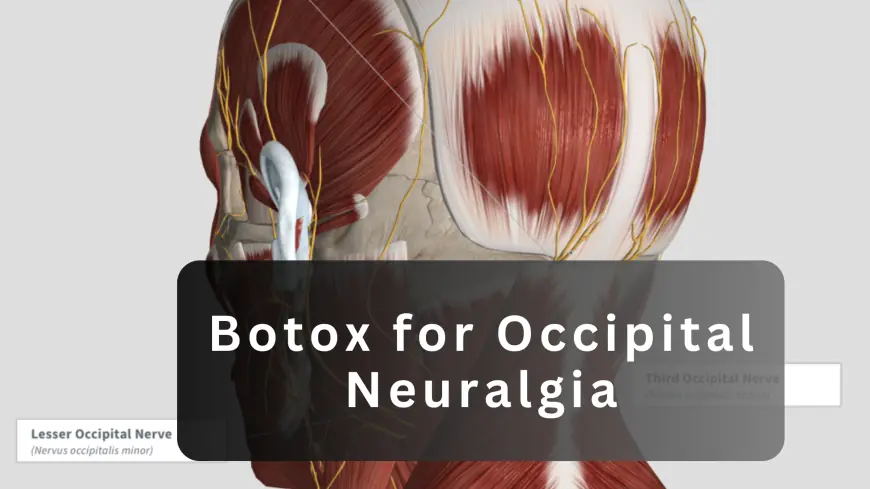Comparing Botox and Traditional Treatments for Occipital Neuralgia

Examining their efficacy, advantages, and limits, this paper contrasts Botox of occipital neuralgia with conventional treatments. It emphasizes choices including drugs, nerve blocks, and surgery; it also shows Botox as a contemporary, minimally invasive way to properly address occipital neuralgia problems.
Strong pain in the back of the head, neck, and scalp defines the crippling disorder known as occipital neuralgia. It starts when the occipital nerves that pass through these regions become compressed or inflammatory. For patients with this disorder, choosing the correct course of treatment is really vital. Let's investigate how Botox for occipital neuralgia stacks against conventional treatments.
Understanding Occipital Neuralgia and Its Symptoms
Often mimicking other headaches, occipital neuralgia makes diagnosis challenging. Among the symptoms include scalp sensitivity, light sensitivity, and stabbing ache. Early identification of these symptoms will improve the results of treatment.

Should you have attempted conventional treatments without success, you could ponder whether more recent choices such as Botox could provide alleviation. Both approaches have benefits; nevertheless, their success depends on the person.
Conventional Remarks on Occipital Neuralgia Treatment
Standard treatments try to reduce pain and inflammation. Among the most often occurring choices are:
-
Medications: For symptoms, muscle relaxants, NSAIDs, and anticonvulsants can all assist. Still, long-term use may have severe consequences including tiredness or stomach issues.
-
Nerve Blocks: Anesthetics injected straight into the afflicted nerves offer brief pain alleviation. While good for acute pain, several treatments could be required.
-
Physical Therapy: Massages and exercises meant to relax the shoulders and neck can help lower nerve inflammation.
-
Surgical Interventions: In severe cases, decompression of the occipital nerves could be advised through surgery. Because of its intrusive character, surgery is usually a last choice.
Usually addressing symptoms rather than the underlying problem, conventional treatments Many people receive alleviation, while others look for substitutes when these approaches fall short.
Modern Approach: Botox for Occipital Neuralgia
Though mostly used for cosmetic purposes, Botox has become a creative solution for occipital neuralgia. Approved by the FDA for chronic migraines, it is now more often used for nerve-related pain.
How does Botox function? By relaxing muscles surrounding the occipital nerves, Botox stops nerve signals generating pain. For many people, this lessens inflammation and tension, therefore offering comfort.
What are the Benefits?
-
Long-lasting Relief: Many times, patients have less discomfort for up to three months following treatment.
-
Minimally Invasive: Botox injections are rapid and demand no recuperation period, unlike surgery.
-
Few Side Effects: The most often occurring side effect at the injection site is mild edema or bruising.
It is crucial to realize, nevertheless, that everyone reacts to Botox differently. Though rare, some people get Occipital neuralgia after Botox. Whether this treatment is appropriate for you will depend on careful consultation with a physician.

Comparing Efficacy: Botox vs. Traditional Treatments
There is a place for both Botox and conventional treatments in controlling occipital neuralgia. Which is best will rely on your particular symptoms, medical background, and reaction to past treatments.
1. Effectiveness: Conventional techniques like nerve blocks offer quick but transient relief. Though it may take several weeks to fully reveal its effects, Botox provides longer-lasting results.
2. Invasiveness: While surgery is somewhat intrusive, most conventional treatments including Botox are non-invasive or less invasive.
3. Cost: Although Botox for occipital neuralgia may be more expensive upfront, over time its long-lasting effects make it more affordable. Different insurance covers mean that you should review your plan.
4. Side Effects: While both procedures are usually safe, Botox has less systemic negative effects than long-term drug use.
What to Expect from Botox Treatment?
You will be extensively evaluated before beginning Botox. Your provider will review your medical history, symptoms, and any past treatments. Usually lasting ten to fifteen minutes, the injection process is fast.
Many individuals say their discomfort is much less after treatment. Maintaining regular follow-ups helps one to track development and decide whether more meetings are required.
Integrating Treatment with Lifestyle Changes
Combining lifestyle modifications with treatment will improve outcomes. These ideas help you support your recovery:
-
Practice Good Posture: Bad posture might tax the occipital nerves. Little changes help to release tension.
-
Manage Stress: Yoga and meditation help to relax muscles and soothe nerve irritability.
-
Stay Active: Mild workouts help to develop shoulder and neck muscles, so improving the support for the occipital nerves.
-
Avoid Triggers: Determine and steer clear of behaviors like extended screen time or uncomfortable sleeping postures that aggravate your symptoms.
Getting the Correct Treatment for You
Whether you decide on Botox or more conventional techniques, the objective is to get relief and raise your quality of life. Our specialty at the Migraine Surgery Specialty Center is individualized treatment. Our professionals will walk you through the alternatives so you can decide with knowledge.
We want to enable you to take back control over your life by combining medical knowledge with a sympathetic approach.
In Essence
Though it's a difficult disorder, developments like Botox give fresh hope for long-term recovery. Although many people find traditional treatments to be still helpful, Botox offers a minimally intrusive substitute with fewer side effects. Knowing your choices and working with a specialist will help you to find the best answer for your situation.Get ready to investigate Botox or other occipital neuralgia treatments; contact Migraine Surgery Specialty Center now to arrange a consultation. Let's cooperate to develop a treatment strategy fit for you!












